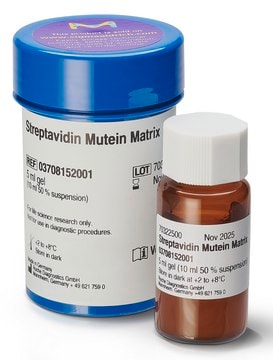11685597910
Roche
Biotin RNA Labeling Mix
sufficient for 20 reactions (transcription), pkg of 40 μL, solution
Synonym(s):
Biotin
Sign Into View Organizational & Contract Pricing
All Photos(1)
About This Item
UNSPSC Code:
41105500
Recommended Products
form
solution
Quality Level
usage
sufficient for 20 reactions (transcription)
packaging
pkg of 40 μL
manufacturer/tradename
Roche
impurities
Ribonuclease, none detected
color
colorless
solubility
water: miscible
storage temp.
−20°C
Related Categories
General description
Convenient nucleotide mixture for the labeling of RNA with Biotin-16-UTP.
Specificity
Heat inactivation: Stop the reaction by adding 2 μl 0.2 M EDTA (pH 8.0).
Application
Biotin RNA Labeling Mix has been used for RNA labeling with Biotin-16-UTP by in vitro transcription with SP6, T7, and T3 RNA polymerases.
Biotin-labeled RNA is also used in a variety of hybridization techniques:
Biotin-labeled RNA is also used in a variety of hybridization techniques:
- Southern blots
- Northern blots
- Dot blots
- Plaque or colony lifts
- RNase protection experiments
- In situ hybridizations
- Microarray hybridizations
- RNA pull down assay
Features and Benefits
Contents
10x concentrated solution with: 10mM each ATP, CTP, GTP, 6.5mM UTP, 3.5mM Biotin-16-UTP, pH 7.5
10x concentrated solution with: 10mM each ATP, CTP, GTP, 6.5mM UTP, 3.5mM Biotin-16-UTP, pH 7.5
Quality
Function tested in combination with the DIG RNA Labeling Kit.
Principle
Biotin-labeled, single-stranded RNA probes of defined length are generated by in vitro transcription. Biotin-16-UTP is incorporated by SP6, T7, and T3 RNA polymerases at approximately every 20 to 25th nucleotide of the transcript under the conditions described below. The Biotin RNA Labeling Mix is specifically designed for the use with Roche SP6,T7, and T3 RNA Polymerases, which are supplied with an optimized transcription buffer.
Preparation Note
Assay Time: 135 minutes
Sample Materials
Sample Materials
- Linearized plasmid DNA: The DNA to be transcribed is cloned into the polylinker site of an appropriate transcription vector which contains adjacent to the polylinker a promoter for SP6, T7 or T3 RNA polymerase. For the synthesis of ′run off′ transcripts the plasmid is linearized by a restriction enzyme. Restriction enzymes creating 5′-overhangs should be used; 3′ overhangs should be avoided. The linearized template DNA should be purified by phenolchloroform extraction and ethanol precipitation, to avoid RNase contamination. For ′run around′ transcription circular plasmid DNA is used.
- PCR product: PCR-fragments which contain RNA polymerase promoter sequences can also act as templates for transcription. Purification of the correct PCR fragment by gel electrophoresis prior to transcription is recommended.
- Labeling Efficiency :A standard labeling reaction with 1μg linear template DNA and an RNA polymerase produces approx. 10μg of full-length, biotin-labeled RNA. In a spot test, a combination of anti-biotin-AP and the chemiluminescence substrate CSPD can detect as little as 0.3pg of the biotin-labeled RNA.
Other Notes
For life science research only. Not for use in diagnostic procedures.
WGK
WGK 1
Flash Point(F)
does not flash
Flash Point(C)
does not flash
Certificates of Analysis (COA)
Search for Certificates of Analysis (COA) by entering the products Lot/Batch Number. Lot and Batch Numbers can be found on a product’s label following the words ‘Lot’ or ‘Batch’.
Already Own This Product?
Find documentation for the products that you have recently purchased in the Document Library.
Customers Also Viewed
Bing Chen et al.
Scientific reports, 6, 23330-23330 (2016-03-22)
An increasing number of long noncoding RNAs (lncRNAs) have been discovered with the recent advances in RNA-sequencing technologies. lncRNAs play key roles across diverse biological processes, and are involved in developmental regulation. However, knowledge about how the genome-wide expression of
Long non-coding RNA AK093407 promotes proliferation and inhibits apoptosis of human osteosarcoma cells via STAT3 activation.
Yongkun W,et al
American Journal of Cancer Research, 7(4), 892-902 (2017)
Andrea Bleckmann et al.
Methods (San Diego, Calif.), 98, 66-73 (2015-11-03)
First evidence on gene function and regulation is provided by the cellular expression pattern in complex tissues. However, to understand the activity of a specific gene, it is essential to analyze the regulatory network, which controls the spatio-temporal translation pattern
Henrik Lindehell et al.
Chromosoma, 124(3), 385-395 (2015-02-20)
In Drosophila, the male-specific lethal (MSL) complex specifically targets the male X chromosome and participates in a twofold increase in expression output leading to functional dosage compensation. The complex includes five proteins and two non-coding RNAs (ncRNAs). A number of
Oskar Marín-Béjar et al.
Methods in molecular biology (Clifton, N.J.), 1206, 87-95 (2014-09-23)
Recent advances in genomics have revealed that cells encode thousands of noncoding RNA molecules that do not require translation to proteins to perform their biological roles. Although very little is known about the mechanisms of function of noncoding RNAs, these
Our team of scientists has experience in all areas of research including Life Science, Material Science, Chemical Synthesis, Chromatography, Analytical and many others.
Contact Technical Service





